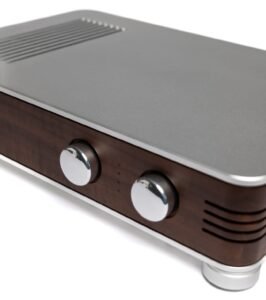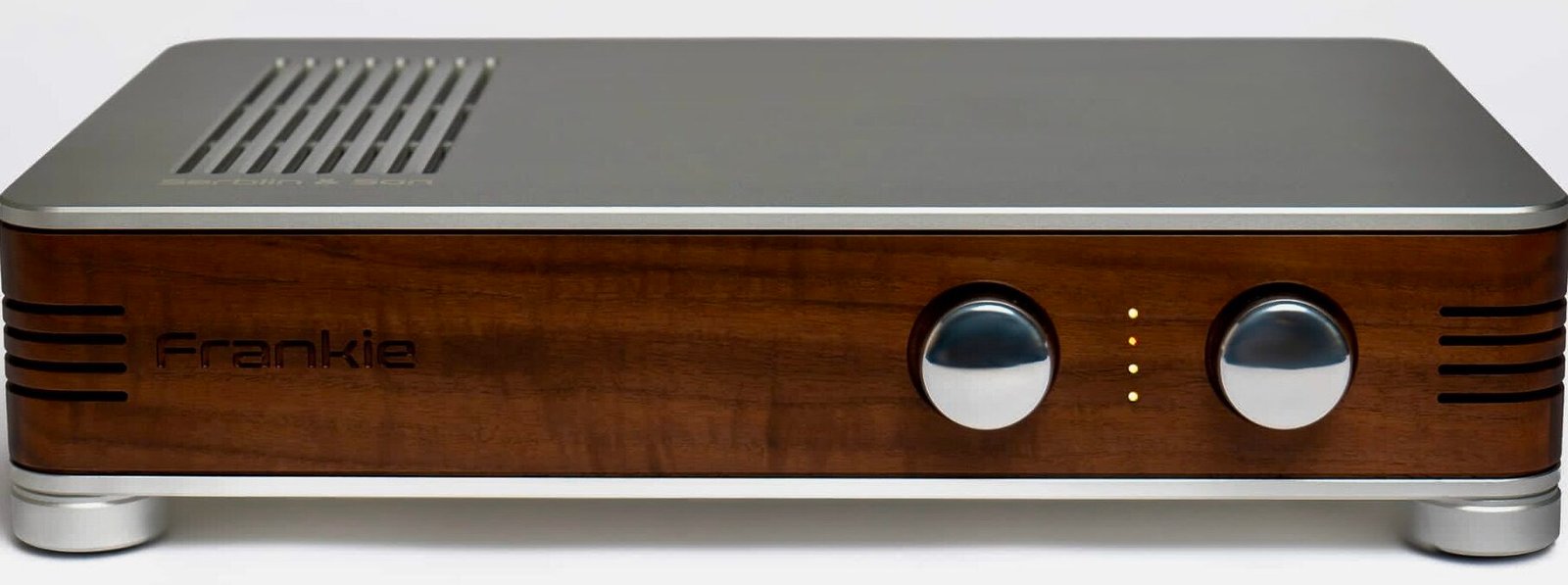Despite being a common place, this writer couldn’t resist, this integrated amplifier gave me, indeed, all the hints to fall into the cliché of using Toto Cotugno’s music. Whether it’s the obvious care this amplifier received in the design phase, the user interface aspects, or the sonic personality it demonstrated.
The Serblin & Son Frankie integrated amplifier is a class A/B push-pull with a proprietary circuit architecture developed in-house by the manufacturer. It delivers 75 Watts at 8 Ohms and 110W at 4Ω, with power supplied by a toroidal transformer – always good news.
According to information provided by Portugal’s representative, all components are of superior quality, especially when compared to most competitors in the same price range. Volume is controlled by a bank of fixed resistors switched by relays, with 127 steps, which is also a positive feature. The rotary volume knob turns the amplifier on and off, and it automatically turns off after 20 minutes without receiving a signal.

Serblin & Son Frankie EX
The Frankie comes equipped with a MM and MC phono stage, switchable and configurable on the rear panel by a dip switch, with 6 bands per channel. Quite rare in an integrated amplifier, not only considering the price but mainly due to the demonstrated sound quality. In addition to connecting your turntable, this integrated amplifier can accommodate 3 other analog sources (1 of them balanced) and 2 digital sources (1 optical and 1 coaxial). The USB-A port is solely for charging purposes. This amplifier can be controlled by phone or tablet through the IOS or Android app, serving as an alternative to the remote control. In the unit provided for review, it comes equipped with a high-quality DAC but does not include a streaming module.
What the eyes can see:

Serblin & Son Frankie
“Beauty is in the eye of the beholder,” or as the Portuguese saying goes, tastes are not to be debated. But feast your eyes on this Italian beauty! Used to a rectangular metal box? Not here, no sir. Here we have a box with rounded corners, made of machined Italian walnut with top and base in satin-finished thick aluminum. From the nation where everything is designed with taste and care, nothing else would be expected. The front is simple, dominated by the matte-finished, manually treated wood, with “Frankie” engraved in bas-relief on the left side. The amplifier’s name is a tribute to Franco Serblin, the uncle of the brand’s founder, Fabio Serblin. Franco, known for founding Sonus Faber and the brand of speakers that now bears his name. On the right side, two hand-polished metal rotary buttons. The first, counting from the left, turns on and controls the volume; the other changes the source. Between them, four “LED lights” indicate the source that is being used. We’ll come back to this.

Serblin & Son Frankie
“Did I read Franco Serblin?” – You did, so at this point, it seems mandatory to clarify for the curious minds, which leads me to the brand’s history. Fabio, after collaborating with his uncle on the two projects mentioned earlier, went his own way. This included production for other brands, importing equipment, and his own production, first with Fase Evoluzione, and later with Serblin & Son. Well done, Fabio. For now, based on what the eyes can see, I’m sold. Let’s see how it is to live with it and how Frankie sings.
Living with Frankie.
This integrated has been in my house for a few months. I commend Filipe Santos , from HomeAudio, the brand representative in Portugal for the patience. I had enough time to see, live with, and listen to this amplifier, and provide a truthful and realistic perspective of what the potential buyer can expect.
But first, a parenthesis: as a consumer, I am a fan of Italian manufacturing. My third car was an Alfa Romeo 147, and from then on, I always bought Italian. Although currently, due to family obligations, my daily driver is a non-Italian seven-seater for the first time in two decades. Mi scusi. In the garage, there’s still an Alfa, the 75 (Milano in America), and of course, a series of Italian peculiarities… which are characteristics aimed at achieving a certain goal but don’t always respect the will of the person in charge of ergonomics in the design office. Namely, the De Dion rear suspension with a mechanical limited-slip differential, with brake discs attached (yes, the wheels have no visible disc-brakes); the handbrake, which in this case is a piece we are accustomed to seeing in airplanes, not to stop but to take off; operating the radio is an operation hindered by the gear lever; which is not a problem for me, as I have Pavarotti and Maria Callas living in the exhaust pipe…
Frankie, being a true Italian, couldn’t escape its DNA: between the two front rotary knobs, there are 4 LED’s indicating the selected source. The top one refers to the turntable and at the same time to the digital source, with the possibility to switch between both with a button on the rear panel, and when you connect the digital source, it switches automatically. Seriously, Fabio? Of course, being Italian, it would be unthinkable to violate the design of the front panel. I got you. Meanwhile, this peculiarity has been reconsidered in the new units currently being sold, with the selection between each source being done linearly and transparently by the right-side rotary button . Each light corresponding to a source.
How does Frankie sing?

Serblin & Son Frankie
I listened to Frankie with the New Horizon 129 turntable provided by Home Audio for the phono stage test and also with my resident turntable, the MoFi StudioDeck, both with MM cartridges. Testing the MC stage of this integrated will be for another occasion. For comparison, I also listened to it with the external Rothwell Simplex phono stage. This integrated did not shy away from the comparison with the external stage. Both played to my liking although with distinct sonic signatures. Frankie’s internal stage was more analytical, and the Simplex was warmer. My advice for those investing in this amplifier would be to try playing their records with the integrated phono stage and, if possible, compare it with an external one. Then draw their own conclusions based on personal taste.
For digital sources, I used the optical input and was impressed with the quality of the integrated DAC, which, at this price range, had to be more than just capable but exceeded my expectations. A pleasant surprise.
So, how did Frankie sound?
Female voices. Immediately, the timbre seemed to seek more fidelity to the source than sweetening reality, although always slightly leaning towards warmth, with good texture definition. I listened to “Meravigliosa Creatura” and felt the texture and hoarseness of Gianna Nannini voice and double bass. Transients are well-defined, thanks in large part to the low noise floor, but without this aspect drawing attention to itself. The duet of “Lakmé” by Delibes, “Fascinação,” and “Romaria” by Elis Regina enchanted me even more deeply than usual. The musicians are well defined in space in Bob Marley & the Wailers’ “Exodus,” but without their edges not appearing “sharp” as some other equipment seems to attempt. Sound stage is wide well beyond the speakers, with reasonable depth.
Piano? In “Porto Sentido” by Carlos do Carmo with Bernardo Sassetti, a track that often gives me the chills with other equipment, here, Frankie paired with the Indiana Line Diva 252 monitors, it approached the timbre that I imagine is close to what actually was heard at the recording session, and without the excessive brightness that often caused me chills in other equipment. This music served as another showcase for the low noise floor of this amplifier. Competent, dynamic, and powerful attack but without being overwhelming in Vivaldi’s “Quattro Stagioni.”
Male voices: “The Sound of Silence” by The Ghost of Johnny Cash showed a generous zest, despite the small size of the monitors used in this test. Frankie proved to be a true Italian, not only for the care put into its design but also for reflecting some stubbornness of the designer in yielding in one or another aesthetic aspect in relation to the ergonomics (now resolved), but above all for its sonic personality, which, despite being able to distinguish the finest details and nuances, also demonstrated Latin muscle and determination. Congratulations, Fabio, this integrated is a great tribute to Uncle Franco!
Equipment in this review:
- integrated amplifier with phono stage and DAC: Serblin & Son Frankie EX (available in Portugal and Spain)
- turntables: MoFi StudioDeck (available in Portugal); New Horizon 129 (available in Portugal and Spain)
- speakers: Indiana Line Diva 252 (available in Portugal and Spain)
- external phono stage: Rothwell Simplex (Available in Portugal)
- Cabling: Ansuz Mainz e Ansuz Speaks (Available in Portugal)
